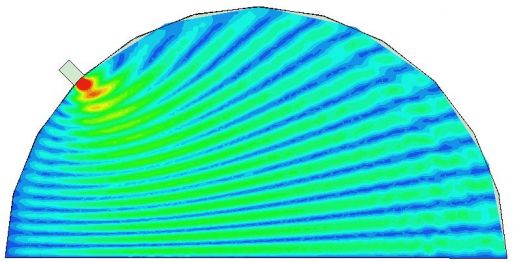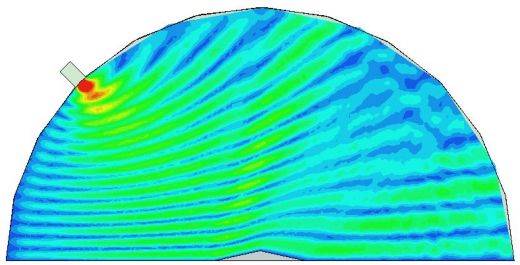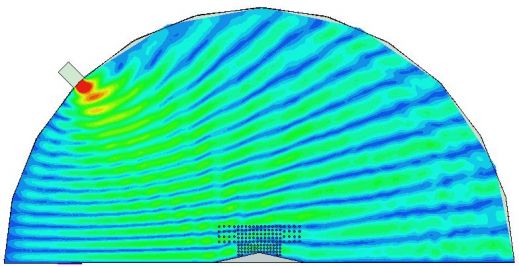 Menu
Menu
Achieving invisibility
Invisibility has captured the imagination of people all around the world throughout history. Legends, myths and fairy stories have all used this concept, and recently fantasies which have “magic” devices that make characters invisible, like “The Lord of the Rings” and “Harry Potter”, have become hugely popular.
Perhaps because of the popularity of these stories, recent news articles reporting on scientific attempts to make “invisibility cloaks” have received wide-spread interest. Most of these systems are for electromagnetic waves (e.g., radio and light). Some are designed for sound waves, with applications in the acoustics of concert halls and recording studios, amongst others. Some research is even applying these techniques to seismic waves, protecting objects from earthquakes, and ocean waves, protecting oil rigs.
One way to design these cloaks is using a novel technique called transformation optics. This design theory allows scientists to change the path of the electromagnetic wave by implementing specially-engineered materials that manipulate the emission, propagation and absorption of electromagnetic radiation. These designs go far beyond what can be accomplished with traditional materials in the form of lenses and mirrors, requiring both materials with graded-index coatings and also those with properties that cannot be found in nature, meaning that artificial “metamaterials” have to be used. These metamaterials have a complex internal structure and are in the early stages of development, making them difficult to fabricate.
As part of the work in QUEST, researchers are utilising the theory of transformation optics to design antennas and other microwave devices that crucially avoid the need for metamaterials by using an alternative approach. Current tried-and-tested fabrication techniques can therefore be used to manufacture devices that can operate over a wide range of frequencies.
This approach is based on nano-composite 'all dielectric' materials; as an example, a ground-plane cloaking device was designed, formed from polyurethane mixed with nano-spheres of barium titanate (BaTiO3), with an average particle size of 200 nm. One of the most attractive features of polyurethane to our application is that it can be produced in the form of foam; a gas produced in the process causes bubbles within the polymer. This will reduce the effective permittivity of the mixture, required as part of the design, while also decreasing weight. Furthermore, it exhibits low dielectric loss. In contrast to previous cloaks, it is not necessary to use metamaterials consisting of sub-wavelength resonant elements, which are inherently narrow band and lossy.

Figure 1: Reflections from a flat ground

Figure 2: Reflections from a triangular wedge

Figure 3: Reflections from a wedge and cloak
The three pictures show the basic concept of ground-plane invisibility cloaks. The objective is to surround an object with some other object, so that the light or radio waves act as if neither objects are present. In all the figures, a radio-wave source at the top left has emitted a wave towards the bottom-centre of the picture. In figure 1, all that is present is a flat (metallic) ground. A specific pattern in the “peaks and troughs” of the waves is visible, due to reflections from the ground. In the second figure, a triangular wedge is present. Comparing the two, it is clear that the pattern of peaks and troughs has changed, due to differences in the reflections: there is a region on the right-hand side where the intensity of the waves is reduced (no more “green”), causing a shadow, with two stronger “beams” either side of the shadow. A sensor looking from the right-hand side would detect the object because of these effects.
The third figure shows the triangular wedge with a cloak placed on top. This cloak is a carefully-designed object, in terms of its shape and material properties. Comparing this picture to the other two, we can see that the shadow region and beams are removed and the wave pattern is much closer to that of the flat ground. This makes the object much harder to detect, rendering it effectively invisible. Improving this cloak is an on-going task.
Although the prototype “invisibility cloak” has many practical limitations, it has been used successfully at QMUL to conceal an object on the ground, so that the bump of the object cannot be detected. The material processing technique discussed allows large-scale production of gradient index materials, which can be used to manufacture a large number of transformation devices. The potential of the underlying techniques will have much wider applicability than cloaking alone, in arguably more important applications in designing new antennas and wireless sensors that span communications, energy transfer, and security.
Perhaps one day soon, science will reach the point where invisibility is a common technology. At this point, “magic” will be a reality, for as Arthur C. Clarke once said, “Any sufficiently advanced technology is indistinguishable from magic.”
A version of this article appeared in QMSCI, the student-led Queen Mary Science magazine: http://issuu.com/qmsci/docs/issue03
Thumbnail picture obtained from http://theabstractionist.files.wordpress.com/2011/08/invisibility-face.jpg.

seo plugin http://www.SEORankingLinks.xyz